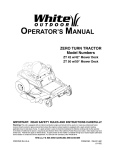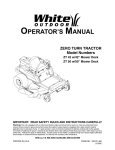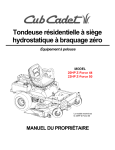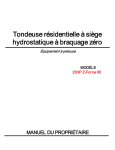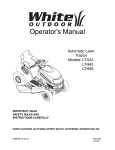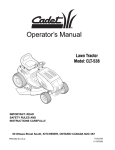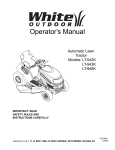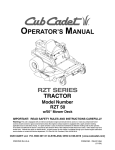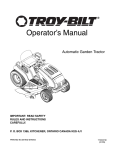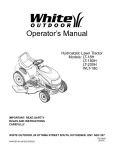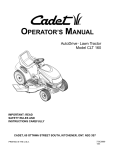Download White Outdoor 772 Operator`s manual
Transcript
Operator’s Manual ZERO TURN TRACTOR Model Numbers ZT 42 w/42” Mower Deck ZT 50 w/50” Mower Deck IMPORTANT: READ SAFETY RULES AND INSTRUCTIONS CAREFULLY. P. O. Box 1386, 97 Kent Avenue, Kitchener, Ontario N2G 4J1 PRINTED IN U.S.A. 769-02897 (11/06) TABLE OF CONTENTS TRACTOR PREPARATION ................................................................................................... 2 IMPORTANT SAFE OPERATION PRACTICES .................................................................... 4 SAFETY DECALS AND LABELS ........................................................................................... 7 RECORDING MODEL AND SERIAL NUMBER INFORMATION ........................................... 9 CUSTOMER SUPPORT ......................................................................................................... 9 TO THE OWNER..................................................................................................................... 9 SLOPE GAUGE .................................................................................................................... 10 SECTION 1: CONTROLS AND FEATURES ........................................................................ 11 SECTION 2: OPERATION ................................................................................................... 15 SECTION 3: ADJUSTMENTS .............................................................................................. 22 SECTION 4: MAINTENANCE .............................................................................................. 23 SECTION 5: MOWER DECK ............................................................................................... 28 SECTION 6: PARTS LIST .................................................................................................... 34 WARRANTY .......................................................................................................................... 35 TRACTOR PREPARATION Remove the upper crating material from the shipping pallet, and cut any bands or tie straps securing the tractor to the pallet. 4. Align the grooves in the seat adjust spacers with the sides of the adjustment slots in the pivot bracket. Use the lift handle to raise the deck to its highest position; engage the transmission bypass rods (Refer to SECTION 1, CONTROLS AND FEATURES); and carefully roll the tractor off the shipping pallet. Disengage the bypass rods. 5. Slide the seat adjust spacers into the slots of the pivot bracket. 6. Continue to push the seat forward in the pivot bracket until the front/left shoulder bolt of the seat assembly passes forward of the stop bracket on the seat pivot bracket. See Figure 1. Remove the deck wash system nozzle adapter and oil drain tube from the manual bag and store for future use. Use the seat adjust lever to adjust the seat position. Refer to "Adjusting the Operator’s Seat" in Section 3 for seat adjustment instructions. INSTALL OPERATOR’S SEAT The operator’s seat was partially inserted into the seat pivot bracket for shipping purposes. To install the seat proceed as follows: 1. Cut any straps securing the seat assembly and the drive control levers. Remove any packing material. Seat Adjustment Slots Seat Pivot Bracket Seat Adjust Spacer NOTE: The seat is partially inserted into the slots of the seat pivot bracket. If the seat does not become disengaged from the pivot bracket when removing the packaging material, the pivot bracket may be pivoted upward and the seat pushed into place as described in step 6. If the seat does disengage the pivot bracket, install the seat as instructed in steps 2 through 6. 2. Pivot the seat pivot bracket partially upward. Refer to Figure 1. Front/Left Shoulder Bolt 3. Note the grooves in the seat adjust spacers attached to the bottom of the seat, then lift the seat and position above and to the rear of the pivot bracket. Stop Bracket Figure 1 2 Seat Adjust Lever NOTE: Make sure the ignition switch is in the "OFF" position before attaching the battery cable. POSITION DRIVE CONTROL LEVERS The drive control levers are unfastened from their respective pivot brackets and lowered for shipping purposes. The control levers must be repositioned and secured to the pivot bracket to operate the tractor. Reposition the control levers as follows: • Remove the hex screw, flat washer, and flange lock nut from the slot of one of the drive control levers. • Lift and swing that control lever upward until the slotted hole in the lever bracket aligns with one of the holes in the pivot bracket. Refer to Figure 2. • 1. Pull the protective cap off the negative terminal of the battery, and remove the hex cap screw and nut from the free end of the negative battery cable. 2. Connect the negative battery cable (heavy black) to negative terminal (NEG) of the battery using the hex cap screw and nut. Slide the black terminal cover over the negative terminal of the battery. MODEL ZT42 ONLY Remove The Chute Stop • Locate the chute stop on the right side of the mower, between discharge chute and cutting deck. Slide the flat washer onto the hex screw. From the outside, insert the hex screw w/washer through the control lever slot and the hole of the pivot bracket. Secure with the flange lock nut. See Figure 2. Flange Lock Nut Control Lever • While holding the discharge chute up, rotate the chute stop clockwise and remove. • Discard the chute stop. Lift control lever upward Flat Washer Hex Screw Pivot Bracket Slotted Hole Figure 2 • • Chute Stop Note the relative position of the control lever to the pivot bracket, then repeat the previous steps to reposition the other control lever in approximately the same position. Figure 3 MODEL ZT50 ONLY Lower Deck Discharge Chute Refer to "Adjusting the Drive Control Levers" in Section 3 for instructions on final adjustment of the levers. WARNING: Never operate the mower deck without the discharge chute installed and in the down position. CONNECT THE BATTERY WARNING: Battery posts, terminals and related accessories contain lead and lead compounds. Wash hands after handling. Locate the cable tie holding the deck discharge chute in the up position for shipping purposes. Cut the cable tie and lower the discharge chute. The tractor is shipped with an activated sealed battery, with the positive battery cable factory connected. The negative cable must be connected. 3 IMPORTANT SAFE OPERATION PRACTICES WARNING: This symbol points out important safety instructions which, if not followed, could endanger the personal safety and/or property of yourself and others. Read and fol- low all instructions in this manual before attempting to operate this machine. Failure to comply with these instructions may result in personal injury. When you see this symbol—heed its warning. DANGER: This machine was built to be operated according to the rules for safe operation in this manual. As with any type of power equipment, carelessness or error on the part of the operator can result in serious injury. This machine is capable of amputating hands and feet and throwing objects. Failure to observe the following safety instructions could result in serious injury or death. GENERAL OPERATION 11. Do not put hands or feet near rotating parts or under the cutting deck. Contact with the blade(s) can amputate hands and feet. 12. A missing or damaged discharge cover can cause blade contact or thrown object injuries. 13. Stop the blade(s) when crossing gravel drives, walks, or roads and while not cutting grass. 14. Watch for traffic when operating near or crossing roadways. This machine is not intended for use on any public roadway. 15. Do not operate the machine while under the influence of alcohol or drugs. 16. Mow only in daylight or good artificial light. 17. Never carry passengers. 18. Disengage blade(s) before shifting into reverse. Back up slowly. Always look down and behind before and while backing to avoid a back-over accident. 19. Slow down before turning. Operate the machine smoothly. Avoid erratic operation and excessive speed. 20. Disengage blade(s), set parking brake, stop engine and wait until the blade(s) come to a complete stop before removing grass catcher, emptying grass, unclogging chute, removing any grass or debris, or making any adjustments. 21. Never leave a running machine unattended. Always turn off blade(s), place transmission in neutral, set parking brake, stop engine and remove key before dismounting. 22. Use extra care when loading or unloading the machine into a trailer or truck. This unit should not be driven up or down ramp(s), because the unit could tip over, causing serious personal injury. The unit must be pushed manually on ramp(s) to load or unload properly. 23. Muffler and engine become hot and can cause a burn. Do not touch. 24. Check overhead clearances carefully before driving under low hanging tree branches, wires, door openings etc., where the operator may be struck or pulled from the unit, which could result in serious injury. 1. Read, understand, and follow all instructions on the machine and in the manual(s) before attempting to assemble and operate. Keep this manual in a safe place for future and regular reference and for ordering replacement parts. 2. Be familiar with all controls and their proper operation. Know how to stop the machine and disengage them quickly. 3. Never allow children under 14 years old to operate this machine. Children 14 years old and over should read and understand the operation instructions and safety rules in this manual and should be trained and supervised by a parent. 4. Never allow adults to operate this machine without proper instruction. 5. To help avoid blade contact or a thrown object injury, keep bystanders, helpers, children and pets at least 75 feet from the machine while it is in operation. Stop machine if anyone enters the area. 6. Thoroughly inspect the area where the equipment is to be used. Remove all stones, sticks, wire, bones, toys, and other foreign objects which could be picked up and thrown by the blade(s). Thrown objects can cause serious personal injury. 7. Plan your mowing pattern to avoid discharge of material toward roads, sidewalks, bystanders and the like. Also, avoid discharging material against a wall or obstruction which may cause discharged material to ricochet back toward the operator. 8. Always wear safety glasses or safety goggles during operation and while performing an adjustment or repair to protect your eyes. Thrown objects which ricochet can cause serious injury to the eyes. 9. Wear sturdy, rough-soled work shoes and closefitting slacks and shirts. Loose fitting clothes and jewelry can be caught in movable parts. Never operate this machine in bare feet or sandals. 10. Be aware of the mower and attachment discharge direction and do not point it at anyone. Do not operate the mower without the discharge cover or entire grass catcher in its proper place. 4 25. Disengage all attachment clutches, depress the brake pedal completely and shift into neutral before attempting to start engine. 26. Your machine is designed to cut normal residential grass of a height no more than 10”. Do not attempt to mow through unusually tall, dry grass (e.g., pasture) or piles of dry leaves. Dry grass or leaves may contact the engine exhaust and/or build up on the mower deck presenting a potential fire hazard. 27. Use only accessories and attachments approved for this machine by the machine manufacturer. Read, understand and follow all instructions provided with the approved accessory or attachment. 28. Data indicates that operators, age 60 years and above, are involved in a large percentage of riding mower-related injuries. These operators should evaluate their ability to operate the riding mower safely enough to protect themselves and others from serious injury. 29. If situations occur which are not covered in this manual, use care and good judgment. Contact your authorized dealer for assistance. SLOPE OPERATION Slopes are a major factor related to loss of control and tip-over accidents which can result in severe injury or death. All slopes require extra caution. If you cannot back up the slope or if you feel uneasy on it, do not mow it. For your safety, use the slope gauge included as part of this manual to measure slopes before operating this unit on a sloped or hilly area. If the slope is greater than 15 degrees as shown on the slope gauge, do not operate this unit on that area or serious injury could result. DO: 1. Mow up and down slopes, not across. Exercise extreme caution when changing direction on slopes. 2. Watch for holes, ruts, bumps, rocks, or other hidden objects. Uneven terrain could overturn the machine. Tall grass can hide obstacles. 3. Use slow speed. Choose a low enough speed setting so that you will not have to stop or shift while on the slope. Tires may lose traction on slopes even though the brakes are functioning properly. Always keep machine in gear when going down slopes to take advantage of engine braking action. 4. Follow the manufacturer’s recommendations for wheel weights or counterweights to improve stability. 5. Use extra care with grass catchers or other attachments. These can change the stability of the 5 machine. 6. Keep all movement on the slopes slow and gradual. Do not make sudden changes in speed or direction. Rapid engagement or braking could cause the front of the machine to lift and rapidly flip over backwards which could cause serious injury. 7. Avoid starting or stopping on a slope. If tires lose traction, disengage the blade(s) and proceed slowly straight down the slope. DO NOT: 1. Do not turn on slopes unless necessary; then, turn slowly and gradually downhill, if possible. 2. Do not mow near drop-offs, ditches or embankments. The mower could suddenly turn over if a wheel is over the edge of a cliff, ditch, or if an edge caves in. 3. Do not try to stabilize the machine by putting your foot on the ground. 4. Do not use a grass catcher on steep slopes. 5. Do not mow on wet grass. Reduced traction could cause sliding. 6. Do not shift to neutral and coast downhill. Overspeeding may cause the operator to lose control of the machine resulting in serious injury or death. 7. Do not tow heavy pull behind attachments (e.g. loaded dump cart, lawn roller, etc.) on slopes greater than 5 degrees. When going down hill, the extra weight tends to push the tractor and may cause you to loose control. (e.g. tractor may speed up, braking and steering ability are reduced, attachment may jack-knife and cause tractor to overturn). CHILDREN 1. Tragic accidents can occur if the operator is not alert to the presence of children. Children are often attracted to the machine and the mowing activity. They do not understand the dangers. Never assume that children will remain where you last saw them. a. Keep children out of the mowing area and in watchful care of a responsible adult other than the operator. b. Be alert and turn machine off if a child enters the area. c. Before and while backing, look behind and down for small children. d. Never carry children, even with the blade(s) shut off. They may fall off and be seriously injured or interfere with safe machine operation. e. Use extreme care when approaching blind corners, doorways, shrubs, trees or other objects that may block your vision of a child who may run into the machine. f. Never fuel machine indoors. g. Never remove gas cap or add fuel while the engine is hot or running. Allow engine to cool at least two minutes before refueling. h. Never over fill fuel tank. Fill tank to no more than ½ inch below bottom of filler neck to allow space for fuel expansion. i. Replace gasoline cap and tighten securely. j. If gasoline is spilled, wipe it off the engine and equipment. Move unit to another area. Wait 5 minutes before starting the engine. k. To reduce fire hazards, keep machine free of grass, leaves, or other debris build-up. Clean up oil or fuel spillage and remove any fuel soaked debris. l. Never store the machine or fuel container inside where there is an open flame, spark or pilot light as on a water heater, space heater, furnace, clothes dryer or other gas appliances. m. Allow a machine to cool at least 5 minutes before storing. f. To avoid back-over accidents, always disengage the cutting blade(s) before shifting into reverse. The “Reverse Caution Mode” should not be used when children or others are around. g. Keep children away from hot or running engines. They can suffer burns from a hot muffler. h. Remove key when machine is unattended to prevent unauthorized operation. 2. Never allow children under 14 years old to operate the machine. Children 14 years old and over should read and understand the operation instructions and safety rules in this manual and should be trained and supervised by a parent. TOWING 1. Tow only with a machine that has a hitch designed for towing. Do not attach towed equipment except at the hitch point. 2. Follow the manufacturers recommendation for weight limits for towed equipment and towing on slopes. 3. Never allow children or others in or on towed equipment. 4. On slopes, the weight of the towed equipment may cause loss of traction and loss of control. 5. Travel slowly and allow extra distance to stop. 6. Do not shift to neutral and coast downhill. GENERAL SERVICE: 1. Never run an engine indoors or in a poorly ventilated area. Engine exhaust contains carbon monoxide, an odorless, and deadly gas. 2. Before cleaning, repairing, or inspecting, make certain the blade(s) and all moving parts have stopped. Disconnect the spark plug wire and ground against the engine to prevent unintended starting. 3. Periodically check to make sure the blades come to complete stop within approximately (5) five seconds after operating the blade disengagement control. If the blades do not stop within the this time frame, your unit should be serviced professionally by an authorized dealer. 4. Check brake operation frequently as it is subjected to wear during normal operation. Adjust and service as required. 5. Check the blade(s) and engine mounting bolts at frequent intervals for proper tightness. Also, visually inspect blade(s) for damage (e.g., excessive wear, bent, cracked). Replace the blade(s) with the original equipment manufacturer’s (O.E.M.) blade(s) only, listed in this manual. “Use of parts which do not meet the original equipment specifications may lead to improper performance and compromise safety!” 6. Mower blades are sharp. Wrap the blade or wear gloves, and use extra caution when servicing them. 7. Keep all nuts, bolts, and screws tight to be sure the equipment is in safe working condition. 8. Never tamper with the safety interlock system or other safety devices. Check their proper operation SERVICE SAFE HANDLING OF GASOLINE: 1. To avoid personal injury or property damage use extreme care in handling gasoline. Gasoline is extremely flammable and the vapors are explosive. Serious personal injury can occur when gasoline is spilled on yourself or your clothes which can ignite. Wash your skin and change clothes immediately. a. Use only an approved gasoline container. b. Never fill containers inside a vehicle or on a truck or trailer bed with a plastic liner. Always place containers on the ground away from your vehicle before filling. c. When practical, remove gas-powered equipment from the truck or trailer and refuel it on the ground. If this is not possible, then refuel such equipment on a trailer with a portable container, rather than from a gasoline dispenser nozzle. d. Keep the nozzle in contact with the rim of the fuel tank or container opening at all times until fueling is complete. Do not use a nozzle lock-open device. e. Extinguish all cigarettes, cigars, pipes and other sources of ignition. 6 ment manufacturer’s (O.E.M.) parts only, listed in this manual. “Use of parts which do not meet the original equipment specifications may lead to improper performance and compromise safety!” 12. Do not change the engine governor settings or over-speed the engine. The governor controls the maximum safe operating speed of the engine. 13. Maintain or replace safety and instruction labels, as necessary. 14. Observe proper disposal laws and regulations for gas, oil, etc. to protect the environment. regularly. 9. After striking a foreign object, stop the engine, disconnect the spark plug wire(s) and ground against the engine. Thoroughly inspect the machine for any damage. Repair the damage before starting and operating. 10. Never attempt to make adjustments or repairs to the machine while the engine is running. 11. Grass catcher components and the discharge cover are subject to wear and damage which could expose moving parts or allow objects to be thrown. For safety protection, frequently check components and replace immediately with original equip- WARNING: YOUR RESPONSIBILITY Restrict the use of this power machine to persons who read, understand and follow the warnings and instructions in this manual and on the machine. R kg P 1 MAX 20% S30296 Safety Labels found on your unit 7 S30544 F N 2 = + 3 4 5 RECORDING MODEL AND SERIAL NUMBER This Operator’s Manual is an important part of your new lawn tractor. It will help you assemble, prepare and maintain the unit for best performance. Please read and understand what it says. Before you start assembling your new equipment, please locate the model plate on the equipment and copy the information from it in the space provided below. The information on the model plate is very important if you need help from your authorized dealer. • You can locate the model number by looking beneath the seat. A sample model plate is explained below. Model Number Numéro de modèle Serial Number Numéro de série XXXXXXXXXX XXXXXXXXXXX Copy the model number here: Copy the serial number here: WHITE OUTDOOR CANADA KITCHENER, ON N2G 4J1 ENGINE INFORMATION The engine manufacturer is responsible for all engine-related issues with regards to performance, power-rating, specifications, warranty and service. Please refer to the engine manufacturer’s Owner’s/Operator’s Manual packed separately with your unit for more information. CALLING CUSTOMER SUPPORT If you have difficulty assembling this product or have any questions regarding the controls, operation or maintenance of this unit, you can seek help from the experts. Choose from the options below: 1. Visit www.whiteoutdoor.ca for many useful suggestions, click on Customer Support button. 2. Call a Customer Support Representative at 1-800-668-1238. Please have your unit’s model number and serial number ready when you call. See previous section to locate this information. You will be asked to enter the serial number in order to process your call. 8 9 D ON 15° ED L INE, REP RES ENT IN WARNING DOT T GA 15° S LO P E Do not mow on inclines with a slope in excess of 15 degrees (a rise of approximately 2-1/2 feet every 10 feet). A riding mower could overturn and cause serious injury. If operating a walk-behind mower on such a slope, it is extremely difficult to maintain your footing and you could slip, resulting in serious injury. Operate RZT zero turn tractors across the face of slopes rather than up and down. Begin with the first pass across the bottom of the slope and turn uphill at the end of each pass whenever possible. FOL OR A FENCE POST A CORNER OF A BUILDING A POWER POLE SIGHT AND HOLD THIS LEVEL WITH A VERTICAL TREE USE THIS PAGE AS A GUIDE TO DETERMINE SLOPES WHERE YOU MAY NOT OPERATE SAFELY. SLOPE GAUGE (Keep this sheet in a safe place for future reference.) SECTION 1: CONTROLS AND FEATURES B O C A C N M D E L J F F G K H Figure 4 A. B. C. D. E. F. G. Deck Height Index Deck Lift Handle RH and LH Drive Control Levers Ignition Switch PTO Switch Transmission Bypass Rod (Not Shown) Cup Holder H. J. K. L. M. N. O. 10 Storage Tray Seat Adjustment Lever (Not Seen) Fuel Tank Cap Hour Meter /Indicator Panel Throttle Control Choke Control—Model ZT50 ONLY Parking Brake Engagement Lever NOTE: References to LEFT, RIGHT, FRONT, and NOTE: To prevent accidental starting and/or battery discharge, remove the key from the ignition switch when the tractor is not in use. REAR indicate that position on the tractor when facing forward while seated in the operator’s seat. A. Deck Height Index The deck height index consists of six index notches located on the front/right of the seat box frame. Each notch corresponds to a 1/2 inch change in the deck height position ranging from 1-1/2 inches at the lowest notch to 4 inches at the highest notch. E. Power Take-Off (PTO) Switch The PTO switch is located on the RH console to the right of the operator’s seat. B. Deck Lift Handle The deck lift handle is located on the front/right of the seat box frame, and is used to raise and lower the mower deck. Pull the handle to the left out of the index notch and push downward to lower the deck, or pull upward to raise the deck. When the desired height is attained, move the lift handle to the right until fully in the index notch. Figure 6 The PTO switch operates the electric PTO clutch mounted on the bottom of the engine crankshaft. Pull the switch knob upward to engage the PTO clutch, or push the knob downward to disengage the clutch. C. RH and LH Drive Control Levers The RH and LH control levers are located to each side of the operator’s seat. These hinged levers open out to the side in the neutral position to permit the operator to be seated or to leave the tractor seat. The levers must be fully opened out in the neutral position to start the tractor engine. Each lever controls the respective RH or LH transmission. Consequently, these levers control all of the movements of the tractor. Driving and steering utilizing these control levers is quite different from conventional tractors, and will take some practice to master. Refer to SECTION 2: OPERATION for instructions on using the control levers. The PTO switch must be in the "disengaged" position when starting the engine. F. Transmission Bypass Rods (Not Shown) The transmission bypass rods (one for each the RH and LH transmission) are located beneath the frame platform, just inside each rear wheel. When engaged, the two rods open a bypass within the hydrostatic transmissions, which allows the tractor to be pushed short distances by hand. Refer to SECTION 4: MAINTENANCE for instructions on using the bypass feature. WARNING: Never tow your tractor. Towing the tractor with the rear wheels on the ground may cause severe damage to the transmissions. D. Ignition Switch The ignition switch is located on the RH console to the right of the operator’s seat. The ignition switch has three positions as follow: G. Cup Holder OFF The cup holder is located toward the rear of the RH console to the right of the operator’s seat. STOP ON H. Storage Tray START The storage tray is located at the rear of the RH console. Figure 5 J. Seat Adjustment Lever (Not Seen) OFF - The engine and electrical system is turned off. ON - The tractor electrical system is energized. START- The starter motor will turn over the engine. Release the key immediately when the engine starts The seat adjustment lever is located below the front/ left of the seat. The lever allows for adjustment of the fore to aft position of the operator’s seat. Refer to SECTION 3: ADJUSTMENTS for instructions on adjusting the seat position. 11 • K. Fuel Tank Cap The fuel tank cap is located at the rear of the LH console. Turn the cap counterclockwise to unscrew and remove from the fuel tank. Always re-install the fuel cap tightly onto the fuel tank after removing. WARNING: Never fill the fuel tank when the engine is running. If the engine is hot from recently running, allow to cool for several minutes before refueling. Highly flammable gasoline could splash onto the engine and cause a fire. Indicator Panel Feature Battery Indicator (Refer to Figure 7) • Illuminates and the battery voltage is displayed briefly when the ignition switch it turned to the "ON" position. L. Hour Meter/Indicator Panel • The hour meter/indicator panel is located on the LH console to the left of the operator’s seat. Battery Indicator Oil Pressure Indicator (optional) • Parking Brake Engaged Indicator This warning lamp indicates low engine oil pressure. If the indicator comes on while the engine is running, stop the engine immediately and check for possible causes. Do not run the engine while this indicator is illuminated. Contact your dealer to have the tractor and engine inspected. PTO Engaged Indicator (Refer to Figure 7) • This indicator illuminates when the PTO switch is pulled upward in the "ENGAGED" position and the ignition switch is turned to the "START" position. Check this indicator if the engine will not crank with the ignition switch in the "START" position. If necessary, move the PTO switch to the "DISENGAGED" position. Figure 7 Hour Meter Feature The hour meter records the hours that the tractor has been operated in the digital display (tenths of an hour-right most digit). NOTE: The hour meter is activated whenever the ignition switch is turned to the "ON" position. Keep a record of the actual hours of operation to assure all maintenance procedures are completed according to the instructions in this manual and the engine manual. • Illuminates to indicate the battery voltage has dropped below 11.5 (+0.5/-1.0) volts. The battery voltage is also displayed on the hour meter. If this indicator and display come on during operation, check the battery and charging system for possible causes and/or contact your dealer. Oil Pressure Indicator (Refer to Figure 7) (optional) Hour Meter PTO Engaged Indicator Every 50 hours a "change oil" message will flash on the display for 2 minutes every time the tractor is started. This message will repeat for the first two hours after each 50 hour interval. The oil pressure indicator light will also flash when this display is active. Follow the oil change intervals provided in the engine manual. Parking Brake Engaged Indicator (Refer to Figure 7) • When key is turned to the "ON" position, the battery indicator light briefly illuminates and the battery voltage is briefly displayed. The display then changes to the accumulated hours. 12 This indicator illuminates when the parking brake is in the DISENGAGED position and the ignition switch is turned to the "START" position. Check this indicator if the engine will not crank with the ignition switch in the "START" position. If necessary, move the parking brake to the ENGAGED position. This indicator also illuminates when the ignition switch is turned to the "START" position and the RH and/or LH drive control levers are in a position other than the fully out in neutral position. Move the control levers fully outward. • M. Throttle Control The throttle control is located on the LH console to the left of the operator’s seat. When set in a given position, a uniform engine speed will be maintained. ZT42 This symbol indicates the fast position. N. Choke Control - Model ZT50 ONLY The choke knob controls the position of the engine choke. Pull the knob out to choke the engine; push the knob in to open the choke. This symbol indicates the slow position. This symbol indicates the choke position. O. Parking Brake Engagement Lever CHOKE ZT50 The parking brake engagement lever is located on the front/left of the seat box frame, and is used to engage the parking brake. This symbol indicates the fast position. • Pull the lever fully upward and to the left and lower into the "J" slot to engage the parking brake. • Pull the lever up out of the "J" slot and to the right; then lower completely to disengage the parking brake. This symbol indicates the slow position. Figure 8 • • Model ZT42 ONLY — When starting the engine, push the control handle fully forward into the "CHOKE" position. See Figure 8. After starting and warming the engine, move the control handle rearward until you feel it move past the choke detent. Push the throttle control handle forward to increase the engine speed. The tractor is designed to operate with the control handle in the fast position (full throttle) when the tractor is driven and the mower deck is engaged. IMPORTANT: If the LH and RH drive control levers are not fully opened out in the neutral position when engaging the parking brake, the engine will stop. The parking brake must be placed in the engaged position when starting the tractor engine. Pull the throttle control handle rearward to decrease the engine speed. 13 SECTION 2: OPERATION GENERAL SAFETY BEFORE OPERATING YOUR TRACTOR • • Before you operate the tractor, study this manual carefully. It has been prepared to help you operate and maintain your tractor efficiently. • Familiarize yourself with the operations of all the instruments and controls. • This engine is certified to operate on unleaded gasoline. For best results, fill the fuel tank with only clean, fresh, unleaded regular or premium gasoline. DO NOt use leaded gasoline. • Some fuels are gasoline blended with alcohols or ethers. The maximum alcohol percentage for ethanol and gasahol blends is 10%. The maximum ether percentage for MTBE or ETBE blends is 15%. If undesirable operating symptoms occur, use gasoline with a lower percentage of alcohol or ether. Do not use gasoline that contains Methanol. • Check the engine oil level. See Engine Manual. IMPORTANT: Your tractor is shipped with motor oil in the engine. However, you MUST check the oil level before operating. The capacity of the engine and oil filter is approximately 62 oz. (1.83 liters) for the model ZT42 and 80 oz. (2.36 liters). for the model ZT50. Be careful not to overfill. • Clean the air cleaner element if necessary. See Engine Manual. • Check the tire inflation pressures. • Adjust the seat for operator’s maximum comfort, visibility, and for maintaining complete control of the tractor. • • • • • • • • • • • • • • RECEIVE INSTRUCTION - Read the operator’s manual. Learn to operate this machine SAFELY. Don’t risk INJURY or DEATH. Allow only those who have become competent in its usage to operate this tractor . Familiarize yourself with the operations of all the instruments and controls. Before starting the engine or beginning operation, be familiar with the controls. The operator should be in the operator’s seat. The PTO switch must be in the disengaged position, the parking brake engaged, and the RH and LH drive control levers moved fully outward in the neutral position. Keep all shields in place. Keep away from moving parts. NO RIDERS! Keep all people and pets a safe distance away. Look behind and down to both sides of the tractor before and while backing up. DO NOT direct the mower discharge at people. Avoid slopes where possible. Never operate on slopes greater than 15°. Slopes with a greater incline present dangerous operating conditions. Tractors can be rolled over. Before leaving the operator’s seat: Shut off the PTO, move the RH and LH drive control levers fully outward in the neutral position, engage the parking brake, shut off the engine and remove the ignition key. Wait for all movement to stop before servicing or cleaning. Operate the drive control levers smoothly and avoid any sudden movements of the levers when starting and stopping. Keep a firm grip on the control levers; do not allow the levers to return to neutral on their own. Be careful when operating near roadways. Stop the tractor motion and wait for vehicles to pass before operating along the road. Do not operate the tractor with the mower deck removed. Removal of the deck will change the balance of the tractor, and could contribute to a tractor rollover. Avoid operation on traction surfaces that are unstable; use extreme caution if the surface is slippery. Slow down before turning and come to a complete stop before any zero turn maneuver. Do not stop the tractor or park the tractor over combustible materials such as dry grass, leaves, debris, etc. Do not fill the fuel tank when the engine is running or while the engine is hot. Allow the engine several minutes to cool before refueling. Tighten the fuel cap securely. SAFETY INTERLOCK SYSTEM This tractor is equipped with a safety interlock system for the protection of the operator. If the interlock system should ever malfunction, do not operate the tractor. Contact your authorized Dealer. 14 • The safety interlock system prevents the engine from cranking or starting unless the RH and LH drive control levers are moved fully outward in the neutral position, the parking brake is engaged, and the PTO is disengaged. • To avoid sudden movement when disengaging the parking brake, the safety interlock system will shut off the engine if the RH and/or LH drive control levers are moved to a position other than the fully out in neutral position when the parking brake is engaged • The safety interlock system will shut off the engine if the operator leaves the seat before engaging the parking brake. • The safety interlock system will shut off the engine if the operator leaves the seat with the PTO engaged, regardless of whether the parking brake is engaged. NOTE: The PTO switch must be moved to the “OFF” position to restart the engine. • The safety interlock system will shut off the PTO and the mower blades will stop if both drive control levers are moved into the reverse position. The PTO will re-engage when one or both of the levers are moved back to the neutral or forward position. • Model ZT50 ONLY 1. Pull the choke control knob upward to the full choke position. NOTE: If the engine is warmed up, it may not be necessary to choke the engine. 2. Move the throttle control lever fully forward to the "fast" position. LH Control Lever Out in Neutral Parking Brake Engaged RH Control Lever Out in Neutral STARTING THE ENGINE WARNING: For personal safety, the operator must be sitting in the tractor seat when starting the engine. ZT50 - Pull Choke WARNING: This unit is equipped with a safety interlock system designed for the protection of the operator. Do not operate the tractor if any part of the interlock system is malfunctioning. Periodically check the functions of the interlock system for proper operation. • Move the RH and LH drive control levers fully outward in the neutral position. Refer to Figure 9. • Operator must be sitting in the tractor seat. • Engage the parking brake. Refer to Figure 9. • Make certain the PTO switch is in the disengaged (down) position. Refer to Figure 9. • ZT42 - Move Throttle Control to Choke ZT50 - Move Throttle Control to "FAST" PTO Switch in Down (Disengaged) Position Figure 9 3. Turn the ignition key clockwise to the “START” position and release it as soon as the engine starts; however, do not crank the engine continuously for more than 5 seconds at a time. If the engine does not start within this time, turn the key to “OFF” and wait a minute to allow the engine’s starter motor to cool. Try again after waiting. Model ZT42 ONLY 1. Move the throttle control lever fully forward into the "CHOKE" position. NOTE: If the engine is warmed up, it may not be necessary to place the throttle control in the choke position. 2. Turn the ignition key clockwise to the “START” position and release it as soon as the engine starts; however, do not crank the engine continuously for more than 5 seconds at a time. If the engine does not start within this time, turn the key to “OFF” and wait a minute. Try again after waiting. 4. As the engine warms up, gradually push the choke knob downward to open the choke. Do not use the choke to enrich the fuel mixture, except as necessary to start the engine. 3. After the engine starts, gradually pull the throttle control lever rearward past the choke detent position to the FAST position. Do not use the choke to enrich the fuel mixture, except as necessary to start the engine. 15 • Allow the engine to run for a few minutes at mid throttle before putting the engine under load. • Observe the hour meter/indicator panel. If the battery indicator light comes on, immediately stop the engine. Have the tractor inspected by your dealer. COLD WEATHER STARTING Be sure to use the proper oil for the expected temperatures (check the table in the engine manual). Follow the normal engine starting instructions above. However, allow the engine ample time to warm up before putting the tractor under load. NOTE: Always remove the key from the ignition switch to prevent accidental starting or battery discharge if the equipment is left unattended. PRACTICE OPERATION (INITIAL USE) Operating a zero-turn tractor is not like operating a conventional type riding tractor. Although and because a zero-turn tractor is more maneuverable, getting used to operating the control levers takes some practice. USING JUMPER CABLES TO START ENGINE WARNING: Batteries contain sulfuric acid and produce explosive gasses. Make certain the area is well ventilated, wear gloves and eye protection, and avoid sparks or flames near the battery. We strongly recommend that you locate a reasonably large, level and open "practice area" where there are no obstructions, pedestrians, or animals. You should practice operating the tractor for a minimum of 30 minutes. If the battery charge is not sufficient to crank the engine, recharge the battery. If a battery charger is unavailable and the tractor must be started, the aid of a booster battery will be necessary. Connect the booster battery as follows: • Connect the end of one cable to the disabled tractor battery’s positive terminal; then connect the other end of that cable to the booster battery’s positive terminal. • Connect one end of the other cable to the booster battery’s negative terminal; then connect the other end of that cable to the frame of the disabled tractor, as far from the battery as possible. • Start the disabled tractor following the normal starting instructions previously provided; then disconnect the jumper cables in the exact reverse order of their connection. • Carefully move (or have moved) the tractor to the practice area. When performing the practice session, the PTO should not be engaged. While practicing, operate the tractor at approximately 1/2-3/4 throttle and at less than full speed in both forward and reverse. Carefully practice maneuvering the tractor using the instructions in the following section "Driving the Tractor." Practice until you are confident that you can safely operate the tractor. DRIVING THE TRACTOR WARNING: Avoid sudden starts, excessive speed and sudden stops. Have the tractor’s electrical system checked and repaired as soon as possible to eliminate the need for jump starting. WARNING: Do not leave the seat of the tractor without disengaging the PTO, moving drive control levers fully outward in the neutral position, and engaging the parking brake. If leaving the tractor unattended, turn the ignition key off and remove key. STOPPING THE ENGINE • Place the PTO switch in the “OFF” position. • Move the RH and LH drive control levers fully outward in the neutral position. • Engage the parking brake. • Place the throttle control lever in the slow (idle) position. Run the engine for a short time to let engine speed stabilize at the idle speed. • Turn the ignition key to the “OFF” position and remove the key from the ignition switch. 16 • Adjust the operator’s seat to the most comfortable position that allows you to operate the controls. See seat adjustment in the ADJUSTMENTS section. • Release the parking brake. • Move the RH and LH drive control levers inward in the neutral position. See Figure 10. DRIVING FORWARD Faster Control Lever Moved Inward and in Neutral Slower Neutral Position Figure 11 Figure 10 • NOTE: If the control levers are not even in the neutral position, refer to Section 3 and adjust the levers so that they are even. • IMPORTANT: Always maintain your grasp on the drive control levers. Do not release the levers to slow the tractor or to return to neutral. Move the throttle control lever forward to the full throttle position (3500-3600 RPM). NOTE: The tractor and engine are designed to run at full throttle. If performing a practice session, it is preferable that the tractor is operated at less than full throttle (approximately 2500-3000 RPM), but this only applies to practice operation. Turning the Tractor While Driving Forward WARNING: When reversing the direction of travel, we recommend performing gradual ‘U’ turns where possible. Sharper turns increase the possibility of turf defacement, and could affect control of the tractor. ALWAYS slow the tractor before making sharp turns. NOTE: For Model ZT42, make certain the throttle control has not been moved too far forward into the "Choke" position. • To slow the tractor move the controls lever rearward to attain the desired speed, or move the levers to the neutral position to stop the tractor. To drive the tractor, firmly grasp the respective drive control levers with your right and left hands and proceed as follows : • WARNING: Always maintain a firm grip on the control levers. DO NOT release the control levers to slow or stop the tractor; move the levers to the neutral position using your hands. To turn the tractor while driving forward, move the control levers as necessary so that one lever is rearward of the other. The tractor will turn in the direction of the rearward control lever. - To turn to the left, move the left drive control lever rearward of the right lever. See Figure 12. FORWARD LEFT TURN Driving the Tractor Forward WARNING: Keep all movement of the drive control levers slow and smooth. Abrubt movement of the control levers can affect the stability of the tractor and could cause the tractor to flip over, which may result in serious injury or death to the operator. • Slowly and evenly move both drive control levers forward. The tractor will start to move forward. See Figure 11. • As the control levers are pushed farther forward the speed of the tractor will increase. Figure 12 17 IMPORTANT: Always maintain your grasp on the drive control levers. Do not release the levers to slow the tractor or to return to neutral. - To turn to the right, move the right drive control lever rearward of the left lever. See Figure 13. FORWARD RIGHT TURN Turning While Driving Rearward • To turn the tractor while driving rearward, move the control levers as necessary so that one lever is forward of the other. The tractor will turn in the direction of the forward control lever. - To turn to the left while traveling in reverse, move the left drive control lever forward of the right lever. See Figure 15. REARWARD LEFT TURN Figure 13 • The greater the fore-to-aft distance between the two levers, the sharper the tractor will turn. • To execute a "pivot turn," move the turn side drive control lever to the neutral position, while moving the other control lever forward. IMPORTANT: Making a "pivot turn" on grass will greatly increase the potential for defacement of the turf. Driving the Tractor In Reverse Figure 15 WARNING: Always look behind and down on both sides of the tractor before backing up. Always look behind while traveling in the reverse direction. • - To turn to the right while traveling in reverse, move the right drive control lever forward of the left lever. See Figure 16. Slowly and evenly move both drive control levers rearward. The tractor will start to move in the reverse direction. See Figure 14. REARWARD RIGHT TURN DRIVING REARWARD Neutral Position Slower Faster Figure 16 • The greater the fore-to-aft distance between the two levers, the sharper the tractor will turn. • To execute a "pivot turn," move the turn side drive control lever to the neutral position, while moving the other control lever rearward. IMPORTANT: Making a "pivot turn" on grass will greatly increase the potential for defacement of the turf. Figure 14 • As the control levers are pushed farther rearward the speed of the tractor will increase. • To slow the tractor move the controls lever forward to attain the desired speed, or move the levers to the neutral position to stop the tractor. 18 STOPPING THE TRACTOR • Move both drive control levers to the neutral position to stop the motion of the tractor. • Push the PTO switch downward to the disengaged position. • Use the deck lift handle to raise the deck to its highest position. • If dismounting the tractor: - Move the drive control handles fully outward in the neutral position. - Engage the parking brake. - Move the throttle control lever to the fast position if operating a ZT42 tractor, or to the slow position if operating a ZT50 tractor. - Turn the ignition switch to “OFF’” and remove the key from the switch. Executing a Zero Turn WARNING: When executing a zero turn, the tractor MUST BE STOPPED. Executing a zero turn while the tractor is moving can significantly reduce your control of the tractor and will cause severe turf defacement to occur. • Stop the forward or reverse motion of the tractor by moving the two drive control levers to neutral. • To turn clockwise, slowly move the left control lever forward while simultaneously moving the right control lever rearward. See Figure 17. CLOCKWISE ZERO TURN DRIVING ON SLOPES Refer to the SLOPE GAUGE on page 10 to help determine slopes where you may not operate safely. WARNING: Do not operate on inclines with a slope in excess of 15 degrees (a rise of approximately 2-1/2 feet every 10 feet). The tractor could overturn and cause serious injury. • Figure 17 • • To turn counterclockwise, slowly move the right control lever forward while simultaneously moving the left control lever rearward. See Figure 18. • COUNTERCLOCKWISE ZERO TURN Always drive across slopes, never up and down. Control the speed and direction of the tractor using primarily the control lever on the downhill side of the tractor, with the uphill control lever remaining essentially in a fixed position. Avoid turning downhill if possible. Start at the bottom of a slope and work upward. Always slow down before turning. Use extra care and go slowly when turning downhill. OPERATING THE PTO Operate the PTO clutch as follows: • Move the throttle control lever to approximately the mid throttle position. • Pull the PTO switch upward to the “ENGAGED” position. • Advance the throttle lever to the operating speed (full engine speed). • The operator must remain in the tractor seat at all times. If the operator should leave the seat without turning off the power take-off switch, the tractor’s engine will shut off. • The PTO clutch cannot be operated when the tractor is driving in the reverse direction. The PTO will disengage when both drive control levers are moved to the reverse position, and will re-engage when one (or both) control levers are moved to the neutral or forward position. Figure 18 19 IMPORTANT: When stopping the tractor for any reason while on a grass surface, always: USING THE MOWER DECK WARNING: Make certain the area to be mowed is free of debris, sticks, stones, wire or other objects that can be thrown by the rotating blades. • Place the shift lever in neutral, • Engage the parking brake, • Shut engine off and remove the key. Doing so will minimize the possibility of having your lawn ‘‘browned’’ by hot exhaust from your tractor’s running engine. IMPORTANT: Do not engage the mower deck when lowered in grass. Premature wear and possible failure of the ‘V” belt and PTO clutch will result. Fully raise the deck or move to a non grassy area before engaging the mower deck. • Mow across slopes, not up and down. If mowing a slope, start at bottom and work upward to ensure turns are made uphill. • On the first pass pick a point on the opposite side of the area to be mowed. • Engage the PTO clutch using the PTO switch and move the throttle control to the fast position. • Lower the mower deck to the desired height setting using the lift handle. • Slowly and evenly push the RH and LH drive control levers forward to move the tractor forward, and keep the tractor headed directly toward the alignment point. NOTE: The speed of the tractor will affect the quality of the mower cut. Mowing at full speed will adversely affect the cut quality. Control the ground speed with the control levers. • CHECKING THE SAFETY INTERLOCK CIRCUITS Periodically check the safety interlock circuits to ensure they are working properly. If a safety circuit is not working as designed, contact you dealer to have the tractor inspected. DO NOT operate the tractor if any safety circuit is not functioning properly. To check the safety circuits, proceed as follows: When approaching the other end of the strip, slow down or stop before turning. A U-turn is recommended unless a pivot or zero turn is required. • Align the mower with an edge of the mowed strip and overlap approximately 3 inches. • Direct the tractor on each subsequent strip to align with a previously cut strip. • To prevent rutting or grooving of the turf, if possible, change the direction that the strips are mowed by approximately 45° for the next and each subsequent mowing. WARNING: Be careful when crossing gravel paths or driveways. Disengage the PTO and raise the deck to the highest position before crossing. 20 • Sitting in the tractor seat with both drive control levers opened fully outward, disengage the parking brake and momentarily turn the ignition switch to the start position. The engine should not crank. • Engage the parking brake and pull the PTO switch upward to the engaged position. Momentarily turn the ignition switch to the start position; the engine should not crank. • Push the PTO switch downward to the disengaged position and engage the parking brake. Start the engine and move one of the drive control levers from the fully outward neutral position. The engine should stop running. Repeat the procedure with the opposite control lever. • Move both control levers fully outward in the neutral position and disengage the parking brake; then lift upward from the operator’s seat. The engine should stop. • With both control levers fully outward in the neutral position and the parking brake engaged, engage the PTO. Lift upward from the operator’s seat; the engine should stop. • Start the tractor, disengage the parking brake, and move the control levers inward to the neutral operating position. Engage the PTO and move both control lever slowly into the slow reverse position; the PTO should disengage and the mower deck should stop until one or both of the control levers are moved to the neutral or forward position. SECTION 3: ADJUSTMENTS ADJUSTING THE OPERATORS SEAT • To adjust the position of the seat, move and hold the seat adjustment lever toward the left. Slide the seat forward or rearward to the desired position; then release the adjustment lever. Make sure seat is locked into position before operating the tractor. See Figure 19. • Insert the hex screw w/washer through the control lever slot and the pivot bracket.Thread the flange lock nut onto the screw, but do not tighten now. • If you are going to adjust the control levers forward or rearward, proceed to the next step. If not, fully the flange lock nut. Pivot Bracket Seat Control Lever Flat Washer Flange Lock Nut Move Lever to Left Slot Adjustment Lever To adjust the drive control levers forward or rearward, proceed as follows: If not already loose, loosen the flange lock nut and rotate the control lever either forward or rearward to the desired position. See Figure 20. ADJUSTING RH & LH DRIVE CONTROL LEVERS The RH and LH drive control levers can be adjusted up or down and fore-and-aft for the comfort of the operator. The drive control levers can be placed in either of two height positions, or can be moved forward or rearward within the range of the slot in each control lever mounting bracket. NOTE: If the control lever is too tight to move, slightly loosen the hex insert flange lock nut and shoulder screw at the bottom of the control lever. To adjust the drive control lever height, proceed as follows: Remove the nut knob, bell washer, and carriage bolt securing the lever to the pivot bracket. • While supporting the control lever to keep it from falling, remove the hex insert flange lock nut and shoulder screw from the bottom of the control lever and pivot bracket. Refer to Figure 20. • Reposition the control lever to align with the other set of holes in the pivot bracket and insert the shoulder screw removed earlier. Fasten with the hex insert flange lock nut and tighten until snug. Shoulder Screw Figure 20 Figure 19 • Hex Screw Height Adjust Holes 21 • Tighten the flange lock nut to fix the control lever in the adjusted position • Repeat the above procedure to adjust the other control lever into the same position. Adjust so that both levers are even with each other when in the neutral position. SECTION 4: MAINTENANCE ENGINE MAINTENANCE • Engine maintenance procedures and schedules can be found in the engine manual. Follow those instructions for performing engine maintenance. If acid spills on clothing, first dilute it with clean water, then neutralize with a solution of ammonia/ water or baking soda/water. • NEVER connect (or disconnect) battery charger clips to the battery while the charger is turned on, as it can cause sparks. Keep all sources of ignition (cigarettes, matches, lighters) away from the battery. The hydrogen gas generated during charging can be combustible. As a further precaution, only charge the battery in a well ventilated area. Always shield eyes and protect skin and clothing when working near batteries. Using the Engine Oil Drain Valve • Locate the oil drain valve on the left side of the engine. • Pop open the protective cap on the end of the oil drain valve to expose the oil drain port. See Figure 21. • Push the oil drain hose (packed with this manual) onto the oil drain port. Route the opposite end of the hose into an appropriate oil collection container with a capacity great enough to collect the used oil (62 oz.- ZT42; 80 oz.- ZT50). • • • WARNING: Batteries contain sulfuric acid and may emit explosive gases. Use extreme caution when handling batteries. Keep batteries out of the reach of children. Protective Cap Oil Drain Hose BATTERY REMOVAL Turn and Pull Out WARNING: Battery posts, terminals and related accessories contain lead and lead compounds. Wash hands after handling. Oil Drain Valve Figure 21 • The battery is located on the right/rear of the tractor beneath the seat box frame. Push the oil drain valve in slightly, then rotate counterclockwise and pull outward to begin draining oil. See Figure 21. To remove the battery: • HYDROSTATIC TRANSMISSION MAINTENANCE The zero turn tractor is equipped with dual integrated hydrostatic pumps, motors, and transaxles that are sealed and do not require regular maintenance. All service work on the hydrostatic transmissions should be performed by your dealer. • • GENERAL BATTERY INFORMATION • WARNING: • • Remove the two hex tapping screws from the battery holddown bracket and remove the bracket. Use care to avoid losing the trim strip from the bottom of the bracket. Remove the hex cap screw and sems nut securing the black negative battery lead to the negative battery post (marked NEG). Move the cable away from the negative battery post. Remove the hex cap screw and sems nut securing the red positive battery lead to the positive battery post (marked POS). Carefully lift the battery out of the tractor. Install the battery by repeating the above steps in the reverse order. Battery posts, terminals and related accessories contain lead and lead compounds. Wash hands after handling. WARNING: Always connect the positive lead to the battery before connecting the negative lead. This will prevent sparking or possible injury from an electrical short caused by contacting the tractor body with tools being used to connect the cables. Should battery acid accidentally splatter into the eyes or onto the skin, rinse the affected area immediately with clean cold water. If there is any further discomfort, seek prompt medical attention. 22 CHARGING THE BATTERY SERVICING ELECTRICAL SYSTEM Test and, if necessary, recharge the battery after the tractor has been stored for a period of time. • A voltmeter or load tester should read 12.6 volts (DC) or higher across the battery terminals. A fuse is installed to protect the tractor’s electrical system from damage caused by excessive amperage. Always use the same capacity fuse for replacement. If the electrical system does not function, check for a blown fuse. See Figure 22 If you have a recurring problem with blown fuses, have the tractor’s electrical system checked by your White Outdoor dealer. • Charge the battery with a 12-volt battery charger at a MAXIMUM rate of 10 amps. Voltmeter Reading 12.7 12.4 12.2 12.0 State of Charge 100% 75% 50% 25% Charging Time Full Charge 90 Min. 180 Min. 280 Min. GOOD BAD Figure 22 BATTERY MAINTENANCE Relays and Switches The battery is filled with battery acid and then sealed at the factory. However, even a “maintenance free” battery requires some maintenance to ensure its proper life cycle. There are several safety switches in the electrical system. If a function of the safety interlock system described earlier is not functioning properly, have the electrical system checked by your White Outdoor dealer. • Spray the terminals and exposed wire with a battery terminal sealer, or coat the terminals with a thin coat of grease or petroleum jelly, to protect against corrosion. • Always keep the battery cables and terminals clean and free of corrosion. • Avoid tipping. Even a sealed battery will leak electrolyte when tipped. LUBRICATION BATTERY STORAGE • When storing the tractor for extended periods, disconnect the negative battery cable. It is not necessary to remove the battery. • All batteries discharge during storage. Keep the exterior of the battery clean, especially the top. A dirty battery will discharge more rapidly. • The battery must be stored with a full charge. A discharged battery can freeze sooner than a charged battery. A fully charged battery will store longer in cold temperatures than hot. • • Using a pressure lubricating gun, lubricate the front castor axles and pivot axle with a No. 2 multi-purpose grease after every 10 hours of service. • Refer to the "MOWER DECK" section later in this manual for deck lubrication procedures. • Periodically lubricate all other pivot points with a quality lubricating oil. TIRE MAINTENANCE Check the tire air pressure after every 50 hours of operation or weekly. Keep the tires inflated to the recommended pressures. Improper inflation will shorten the service life of a tire. See the tire side wall for proper inflation pressures. Observe the following guidelines: Recharge the battery before returning to service. Although the tractor may start, the engine charging system may not fully recharge the battery. 23 • Do not inflate a tire above the maximum pressure shown on the sidewall of the tire. • Do not reinflate a tire that has been run flat or seriously under inflated. Have a qualified tire mechanic inspect and service the tire. USING THE TRANSMISSION BYPASS RODS TRACTOR CREEPING If for any reason the tractor will not drive or you wish to move the tractor, the two hydrostatic transmissions are equipped with bypass rod that will allow you to manually move the tractor short distances. Creeping is the slight forward or backward movement of the tractor when the engine is running at high idle and the drive control levers are opened out in the neutral position. If after operating the tractor for some time, it begins to creep while in the neutral position, adjust the transmission control rods as follows. • Place the front of the tractor against an immovable object (e.g. wall, post, etc.). • Jack up the rear of the tractor so that both rear wheels are approximately one inch of the ground. • With the engine running at high idle and the drive control levers opened out in the neutral position, and the parking brake disengaged, check the rear wheels for rotation. • If only one wheel is rotating, locate the transmission control rod beneath the frame at the front of the rear tire. If both wheels rotate, locate both control rods. See Figure 24. WARNING: Do not tow the tractor, even with the bypass rod engaged. Serious transmission damage will result from doing so. • From just in front of the two rear tires, locate the transmission bypass rods. See Figure 23. • Pull one rod toward

































